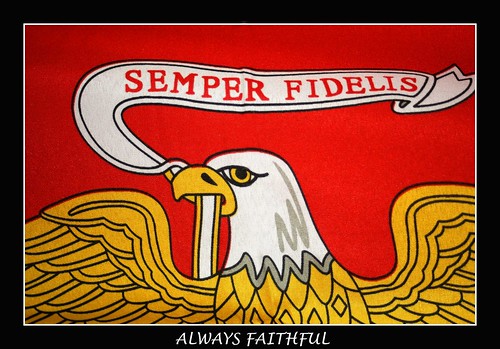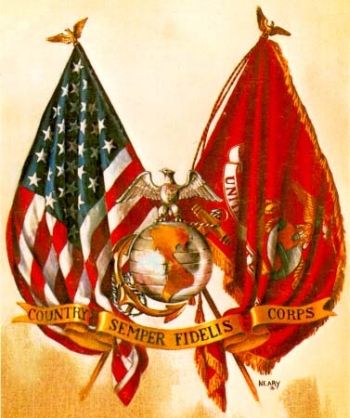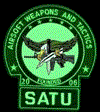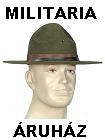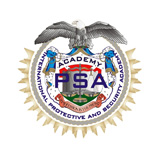US.MARINE CORPS
Hivatalos oldal linkek:
_______________________________________________________________________________________
U.S. Marine Corps története:
1775 November 10-én a Kontinentális Kongresszus határozata alapján
1834-ben a Tengerészgyalogság a Haditengerészet része lett
Jelképe
A sas a földgömb és a horgony jelkép 1868 óta része az egyenruhának, de csak 1955-ben vált a hivatalos jelképévé a Tengerészgyalogságnak.
A sas kitárt szárnyakkal az Egyesült Államok büszke nemzetét jelképezi. A földgömb a világszerte való jelenlétükre utal, míg a horgony a tengerészeti hagyományokat jelképezi. Együtt a szolgálatra való felajánlást fejezik ki levegőben, földön és vízen.
Jelmondata
A hadtest mottója, amelyet 1883-ban fogadtak el ami latinul, a “Semper Fidelis”, “mindig hűséges”.
Általános kifejezések
“First To Fight” – Marines have been in the forefront of every American war since the founding of the Corps. They entered the Revolution in 1775, even before the Declaration of Independence was signed! Marines have carried out more than 300 landings on foreign shores. They have served everywhere, from poles to tropics; their record for readiness reflects pride, responsibility, and challenge.
“Leatherneck” – This nickname goes back to the leather stock or neckpiece, which was part of the Marine Corps uniform from 1775 to 1875. The leather collar was designed to protect the jugular vein from saber slashes. It also insured that Marines kept their heads erect and maintained military bearing. Although no longer used, it is commemorated by the standing collar on the dress blue and dress white uniform.
“Uncommon Valor was a Common Virtue”– Refers to the victories in World War II, especially at Iwo Jima, the largest all-Marine battle in history. Admiral Nimitz’s ringing epitome of Marines fighting on Iwo Jima was applied to the entire Marine Corps in World War II: “Uncommon valor was a common virtue.”
“Devil Dogs” – In the Belleau Wood fighting in 1918, the Germans received a thorough indoctrination into the fighting ability of Marines. Fighting through supposedly impenetrable woods and capturing supposedly untakeable terrain, the men of the 4th Marine Brigade struck terror in the hearts of the Germans, who referred to Marines as the “Teufelhunden”, meaning “fierce fighting dogs of legendary origin” or as popularly translated, “Devil Dogs.”
“THE MARINE CORPS MOTTO” – That Marines have lived up to their motto, “Semper Fidelis” (Always Faithful), is proven by the fact that there has never been a mutiny among U.S. Marines. This motto was adopted about 1883. Before that, there had been three mottoes, all traditional rather than official. The first, “Fortitudine” (With Fortitude), appeared about 1812. The second, “By Sea and by Land,” was obviously a translation of the Royal Marines’ “Per Mare, Per Terram.” Until 1848, the third motto was “To the Shores of Tripoli,” in commemoration of O’Bannon’s capture of Derne in 1805. In 1848, after the return to Washington of the Marine battalion which took part in the capture of Mexico City, this motto was revised to “From the Halls of Montezuma to the Shores of Tripoli.” The current Marine Corps motto is shared with England’s Devonshire Regiment.
“The President’s Own” – Established by an act of Congress in July 1798 (more than a century before the bands of the other three services), the Marine Band has performed at White House functions for every president except George Washington. Thomas Jefferson was especially fond of the band. Because of its traditional privilege of performing at the White House, the band is spoken of as “the President’s Own.”
“Retreat, Hell! We Just Got Here!” – Fighting spirit and determination against heavy odds is a sound tradition in the Marine Corps. Nowhere is there a more graphic illustration than an incident which occurred in World War I. Legendary or true, it personifies the aggressive attitude of Marines. The occasion was the third great German breakthrough of 1918, when the 4th Marine Brigade and its parent 2d Infantry Division were thrown in to help stem the tide in the Belleau Wood sector. The 2d Battalion, 5th Marines had just arrived at its position when an automobile skidded to a stop and a French officer dashed out and approached the commanding officer. He explained that a general retreat was in progress and that orders were for the Marines to withdraw. The Marine officer exclaimed in amazement, “Retreat Hell! We just got here!” The Marines proceeded to prove their point. The battalion deployed and took up firing positions. As the Germans approached, they came under rifle fire which was accurate at ranges beyond their comprehension. Not in vain had the Marine Corps long stressed in its training the sound principles of marksmanship. The deadly fire took the heart out of the German troops, and the attack was stopped.
“Gyrenes” – The term “gyrene”is a jocular reference to Marines which was first used in England as early as 1894. It was used in the United States around the time of World War I. Its exact origin is unknown, but it did appear to have a derogatory meaning in its early usage. It has been suggested that the term may embody a reference to pollywog, a naval slang term for a person who has not yet “crossed” (the equator), hence, a landlubber.
“Jarhead” – A slang term used by sailors as early as World War II to refer to members of the Marine Corps, drawing the term from the resemblance of the Marine dress blues uniform, with its high collar, to a Mason jar which at the time was made from blue glass.
A kezdet
The origins of the Marine Corps can be traced back to the colonial battalions of Marines raised in America before the Revolution and modeled after their British counterparts.
In 1740 four battalions of Marines (3,000 men) were raised for service in Britain’s war with Spain. Designated 43rd Regiment of Foot, they became known as “Gooch’s Marines”, after their commander, Colonel William Gooch. In April 1741 they were involved in a battle at Cartagena, Colombia, and in July 1741, Marines landed unopposed at Guantanamo Bay, Cuba, to secure it as a base for the British fleet.
The Colonial Marines served in the British Navy as marksmen aboard its ships and providing the cutting edge of boarding parties. Their duties also included shipboard security and maintaining discipline among the seamen. History shows numerous incidents where the timely arrival or mere presence of Marines prevented/stopped mutinies.
Revolutionary War – 1775-1783
The US Frigate Alfred landed 268 Marines, under the command of Captain Samuel Nicholas, on New Providence Island in the Bahamas for their first military expedition. Within 13 days the Marine raiding party captured two forts, occupied the town of Nassau, took control of Government House and seized 88 guns, 16,535 shells and other supplies. Nicholas was promoted to Major and in December 1776 he and approximately 300 Marines joined Washington’s Army in Pennsylvania just before the second battle of Trenton.
Marines took part in the attacks on English ships in European waters of the American Ship Reprisal until its loss. In April 1778 a Marine detachment took part in two raids on the soil of Great Britain conducted from the Ranger, commanded by John Paul Jones. Marines from the frigate South Carolina made a landing on the Isle of Jersey in 1781. These were among the few such landings on British soil in over 700 years.
War with Tripoli 1801-1805 “Barbary Pirates”
*Capture of fortress at Derne, Tripoli…..April 25-27, 1805
Marine Lt. Presley N. O’Bannon led a force of Marines and Mercenaries across 600 miles of Libyan desert, to attack the fortress at Derne, Tripoli, while Naval forces provided bombardment. This was the first time an American flag flew over a captured fortification in the “Old World”. In appreciation for O’Bannon’s services, Hamet Bey (the rightful ruler of Tripoli) presented O’Bannon with his own sword, a curved blade with ivory hilt topped by a golden eagles head. The Mameluk sword. This sword served as the pattern for swords carried to this day by Marine Officers.
War of 1812
A battalion of 114 Marines with a few sailors, led by Captain Samuel Miller attempted to defend Washington against 4,000+ British troops. The Marines and sailors inflicted 249 casualties and delayed the attackers for two hours before they were forced to fall back.
300 Marines, under the command of Major Daniel Carmick took part in the defense of New Orleans during British attack.
Massachusetts State Prison Riot – 1824
Inmates rioted and holed up in the mess hall with a guard as hostage, Marines from the Boston barracks came to help. Major RD Wainwright led 30 Marines into the mess hall to confront 283 armed and determined prisoners. Wainwright ordered his men to cock and level their muskets. “You must leave this hall,” he told the inmates. “I give you three minutes to decide. If at the end of that time a man remains, he will be shot dead. I speak no more.” In two and a half minutes, “the hall was cleared as if by magic.”
The Mexican War 1846-1847
*Battle of Chapultepec (Mexico)…..September 13, 1847
The main defensive position be fore Mexico City was Chapultepec, a 200 foot high promontory on top of which stood a stone castle surrounded by a wall that would have to be scaled. It is said that this victory inspired some unknown Marine to compose a brief lyric to a tune popular in that day that wound up being “The Marine Hymn”. Its also supposed to be where the blood stripe on the pant legs of NCO and Officers is from.[/center]
[center][color=#FFFF80][hrtext][b][i]The Civil War[/i][/b][/hrtext][/color][/center]
[center]The Union Marine Corps never exceeded 3,900 men.
The Confederate Marine Corps reached a peak of 600 men.
Marine Corporal John Mackie acts of heroism made him the first Marine to win the Medal of Honor. Mackie was on board the Galena when a direct hit caused an explosion, Mackie rallied the survivors, carried off the dead and wounded and got three of the ship’s guns back in action.
Moonshine Raids in Brooklyn 1867 – 1871
Operators of illegal stills in the area of Brooklyn, New York gave an inhospitable reception to federal revenue agents who attempted to shut down their bootlegging operations, and neither the city’s police nor units of the Army’s 8th Infantry had been able to provide the agents with sufficient protection. The local army commander urged that the Leatherneck unit from the Brooklyn Navy Yard be assigned the task. Soon members of the Corps with bayonets fixed were marching through the area’s streets, guarding revenue officers who searched out and smashed illegal stills.
Boot Camp
The Marine Barracks, Parris Island, South Carolina, established its attached recruit depot in 1915.
A Similar depot was set up at Mare Island, California, which was moved to San Diego in 1923.
http://montney.com/marine/history1.htm
Amióta megalakult a tengerészgyalogság részt vett minden jelentősebb háborúban amit az USA vivott,emellett számos fegyveres beavatkozásban szerte a világban.
Története hatásos és a katonai történetírásban elfoglalt különleges helyét olyan üzközetekkel vívta ki,mint Belleau Wood, Guadalcanal, Iwo Jima, a Chosin-gyűjtómedence vagy Khe Sanh.
_______________________________________________________________________________________
USMC Létszám 173 400 fő
Állomány
* 5 tengerészgyalogos ezred
* 1 harckocsi zászlóalj
* 1 harci támogató zászlóalj
* 1 deszant zászlóalj
* 2 műszaki zászlóalj
* 2 felderítő zászlóalj
* 2 tüzér ezred
Tartalék
* 3 tengerészgyalogos ezred
* 1 tüzér ezred
* 1 deszant zászlóalj
* 1 műszaki zászlóalj
* 1 felderítő zászlóalj
Felszerelés
* 403 db harckocsi (M1 Abrams)
* 400 db közepes harckocsi
* 390 db tüzérségi löveg
Tengerészgyalogság légiereje
* 450 db repülőgép
* 279 db harci helikopter
_______________________________________________________________________________________
Megváltozott városi hadviselés (USMC)
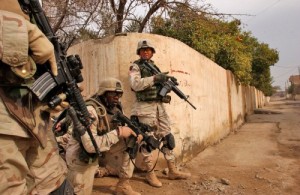
Városi környezetben a helyzet sokkal összetettebb. A katonáknak legtöbbször a főutakon konvojokat kell biztosítaniuk, ellenőrzési pontokon kiszűrni a lakosság között megbúvó fegyvereseket. Az iraki és az afganisztáni akciók újra felhívták a figyelmet arra, hogy a katonai akcióknak még mindig a legfontosabb eleme maga a katona, amit talán egy kicsit elfelejtettek már az amerikai katonai vezetésben.
_______________________________________________________________________________________
USMC Rifle Creed
“This Is My Rifle”
The Creed of a US Marine
This is my rifle. There are many like it, but this one is mine.
My rifle is my best friend. It is my life. I must master it as I must master my life.
My rifle, without me, is useless. Without my rifle, I am useless. I must fire my rifle true. I must shoot straighter than my enemy who is trying to kill me. I must shoot him before he shoots me. I WILL…
My rifle and myself know that what counts in this war is not the rounds we fire, the noise of our burst, nor the smoke we make. We know that it is the hits that count. WE WILL HIT…
My rifle is human, even as I, because it is my life. Thus, I will learn it as a brother. I will learn its weaknesses, its strength, its parts, its accessories, its sights and its barrel. I will ever guard it against the ravages of weather and damage as I will ever guard my legs, my arms, my eyes and my heart against damage. I will keep my rifle clean and ready. We will become part of each other. WE WILL…
Before God, I swear this creed. My rifle and myself are the defenders of my country. We are the masters of our enemy. WE ARE THE SAVIORS OF MY LIFE.
So be it, until victory is America’s and there is no enemy, but peace!
United States Marines, Quotes
|
“First to Fight” |
Marines have been in the forefront of every American war since the founding of the Corps. They have carried out over 300 landings on foreign shores. They have served everywhere, from the poles to the tropics. Their record of readiness reflects pride, responsibility and challenge. |
| “Leathernecks” | The Marines’ long-standing nickname goes back to the leather stock or neckpiece, which was part of the Marine uniform from 1775 to 1875. The leather bands around their throats were intended to ensure that Marines kept their heads erect. |
| “Devil Dogs” | In the Belleau Wood fighting in 1918, the Germans received a thorough indoctrination in the fighting ability of the Marines. Fighting through supposedly impenetrable woods and capturing supposedly untakeable terrain, the persistent attacks, delivered with unbelievable courage soon had the Germans calling Marines “teufelhunden,” referring to the fierce fighting dogs of legendary origin. |
| “Esprit de Corps” | The “spirit” of a unit. This spirit is commonly reflected by all members. It implies devotion and loyalty to the Marine Corps, with deep regard for history, traditions and honor. |
| “Uncommon Valor was a Common Virtue” | Refers to the victories in World War II, especially at Iwo Jima, the largest all-Marine battle in history. Admiral Nimitz’s ringing epitome of Marine fighting on Iwo Jima was applied to the entire Marine Corps in World War II. |
| “Jarhead” | A slang term used by sailors as early as World War II to refer to members of the Marine Corps, drawing the term from the resemblance of the Marine dress blues uniform, with its high collar, to a Mason jar. |
| “Semper Fidelis” | The Motto of the United States Marine Corps. Latin for always faithful. Faithful to god, Country, Family and the Corps. |
| “Once a Marine, Always a Marine” | The motto of the Marine Corps League. Having earned the title of Marine it becomes a integral part of who and what we will become later in life. |
The Marine Corps Prayer
Mindenható Atyánk, aki mindennek parancsol és akinek szerelme soha be nem teljesül, tisztíts meg engem a Te jelenléteddel és tégy engedelmessé akaratod szerint. Tarts meg igazadban, hogy ellenállhassak a becstelenséggel szemben, a céljaiddal és tetteiddel segíts engem életem során, hogy szemébe tudjak nézni Tengerészgyalogos társaimnak, szeretteimnek és előttednek erüljek szégyenbe és félelembe. Védjed otthon maradt családom.
Adj akaratot, hogy ezt a tengernyi feladatot és felelősséget erővel és lelkesedéssel elvégezhessem. Adj nekem bátorságot, hogy minden nap maximális teljesítményt nyújthassak. Tartsa meg lojalitásomat és hűségemet a feletteseim, hazám és a Tengerészgylogság által rám bízott beosztottjaimmal szemben. Segíts, hogy méltósággal viseljem sorsom és emlékeztess naponta Marines hagyományokra, amit fenn kell tartanom.
Ha meghajlanék kétségek közt, erősítsd meg hitem, ha kísértésbe esnék, tégy erőssé, hogy ellen tudjak állni ha kell, Adj jelet és bátorságot, hogy próbáljam meg újra és újra. Mutatsd meg nekem az igazság fényét és adj bölcsességet, hogy megérthessem én is a választ, s hogy meghallgatásra talált imám… ÁMEN
Teufelhunden – “Devil Dogs”
A német hadsereg találta ki a kifejezést “teufel hunden” a tekintetben hogy az amerikai tengerészgyalogság I. világháborúban A 1918 nyarán a német hadsereg visszavonulását követően. Az újonnan érkezett amerikai tengerészgyalogságot dobták be a Párizs melletti erdőkbe. 1918 júniusában, az elkeseredett harcban a tengerészgyalogság többször visszaverte a németeket Belleau Wood-nál. Ezután a tengerészgyalogosok megtámadták és végigverték őket a Belleau Wood-on. Paris megmenekült. Öt hónappal később Németország kénytelen volt elfogadni a fegyverszünetet. A csata kitartása és dühe az amerikai tengerészgyalogság küzdőszelleme megdöbbentette a németeket. A hivatalosan is elkeresztelték őket “Teufel hunden”, azaz Ördög Kutyáknak, a vad hegyi kutyák bajor nemzeti mondakörben.
Semper Fidelis (“Always Faithful”) Mindig Hűséges
Az egység mottója. A tengerészgyalogosok mottója ami szerint élnek azt a tényt bizonítja, hogy még soha nem volt lázadás az egységeikben, sőt még a gondolata sem fogalmazódott meg soha tengerészgyalogságnál.
Semper Fidelis mottót 1883 hivatalosították, mint az egység hivatalos mottója. Ezt megelőzően, három mottó is használatos volt, hagyományok alapján de nem hivatalosan. Az első, Antedating aháborúban 1812-ben, “Fortitudine” (“A Fortitude=Bátorság”). A második, “A tengeren és szárazföldön,” nyilvánvalóan fordítását a Királyi Haditengerészettől származtatható “Per Mare, Per terram.” 1848-ig, a harmadik mottója “A Tripoli partján” emlékére O’Bannon elfogása Derna 1805-ben. 1848-ban miután a tengeri zászlóalj visszatért Washingtonba, hogy részt vegyen Mexico City elfoglalásában, erre a mottója módosították: “A Halls a Montezumasa Shores a Tripoli” – ezt a sort már ismeri az összes amerikai. Ezt követően az alakulat Mexikóban változtatott a szövegen, az első versszakból “A tengerészgyalogosok himnuszában” használták azok, akik megrohamozta Chapultepec várát.
Származása lehet még az Angliai Devonshire ezred, a 11. gyalogosok, akik az egyik magas rangú gyalogsági ezred a brit hadseregben, akik gúnyneve “11. Bloody”, Véres tizenegyesek, amelynek mottója is Semper Fidelis volt.
USMC Customs and Traditions
Battle Color of the United State Marine Corps
Marine Barracks, Washington, D.C., holds the official Battle Colors of the Marine Corps. A duplicate is maintained in the office of the Commandant of the Marine Corps in the Pentagon. The Battle Colors bear the same fifty streamers authorized for the Marine Corps as a whole. These streamers represent U.S. and foreign unit awards as well as those periods of service, expeditions, and campaigns in which the Marine Corps has participated from the American Revolution to today.
During the Marine Corps’ first 150 years, Marines in the field carried a variety of flags. It was not until 18 April 1925 that Marine Corps Order Number 4 designated gold and scarlet as the official colors of the U.S. Marine Corps. These colors, however, were not reflected in the official Marine Corps flag until 18 January 1939 when a new design incorporating the new colors was approved. This design was essentially that of today’s Marine Corps standard, and was the result of a two-year study concerning the design of a standard Marine Corps flag, and the units to which such a flag should be issued.
The fifty colored streamers which adorn the Battle Colors represent the history and accomplishments of the Marine Corps. The newest streamer to be added to the Battle Colors is the Kosovo Campaign Streamer, awarded for service in various Kosovo operations beginning in 1999
USMC Customs and Traditions
Marine Corps Emblem & Seal
 The history of the Marine Corps emblem is a story related to the history of the Corps itself. The emblem of today traces its roots to the designs and ornaments of early Continental Marines as well as British Royal Marines. The emblem took its present form in 1868. Before that time many devices, ornaments, and distinguishing marks followed one another as official marks of the Corps.
The history of the Marine Corps emblem is a story related to the history of the Corps itself. The emblem of today traces its roots to the designs and ornaments of early Continental Marines as well as British Royal Marines. The emblem took its present form in 1868. Before that time many devices, ornaments, and distinguishing marks followed one another as official marks of the Corps.
In 1776, the device consisted of a “foul anchor” of silver or pewter. The foul anchor still forms a part of the emblem today. (A foul anchor is an anchor which has one or more turns of the chain around it). Changes were made in 1798, 1821, and 1824. In 1834 it was prescribed that a brass eagle be worn on the hat, the eagle to measure 3 ½ inches from wingtip to wingtip.
During the early years numerous distinguishing marks were prescribed, including “black cockades”, “scarlet plumes,” and “yellow bands and tassels.” In 1859 the origin of the present color scheme for the officer’s dress uniform ornaments appeared on an elaborate device of solid white metal and yellow metal. The design included a United States shield, half wreath, a bugle, and the letter “M.”
In 1868, Brigadier General Commandant Jacob Zeilin appointed a board “to decide and report upon the various devices of cap ornaments of the Marine Corps.” On 13 November 1868, the board turned in its report. It was approved by the Commandant four days later, and on 19 November 1868 was signed by the Secretary of the Navy.
The emblem recommended by this board consists of a globe (showing the Western Hemisphere) intersected by a foul anchor, and surmounted by a spread eagle. On the emblem itself, the device is topped by a ribbon inscribed with the Latin motto “Semper Fidelis” (Always Faithful). The uniform ornaments omit the motto ribbon.
The general design of the emblem was probably derived from the British Royal Marines’ “Globe and Laurel.” The globe on the U.S. Marine emblem signifies service in any part of the world. The eagle also indirectly signifies service worldwide, although this may not have been the intention of the designers in 1868. The eagle which they selected for the Marine emblem is a crested eagle, a type found all over the world. On the other hand, the eagle pictured on the great seal and the currency of the United States is the bald eagle, strictly a North American variety. The anchor, whose origin dates back to the founding of the Marine Corps in 1775, indicates the amphibious nature of Marines’ duties.
On 22 June 1954, President Dwight D. Eisenhower signed an Executive Order, which approved the design of an official seal for the United States Marine Corps. The new seal had been designed at the request of the Commandant of the Marine Corps, General Lemuel C. Shepherd, Jr.
_________________________________________________________________________
Marine Corps Flag
„The few, the proud” (a kevesek, a büszkék) lobogó
A Tengerészgyalogosok az Amerikai Forradalom óta több zászlóval is rendelkeznek, de napjaink bíbor lobogója 1939. január óta lobog a Tengerészgyalogság ceremóniáin és missziói alatt.
A lobogó bíbor háttere előtt található a Sas, Földgömb és Horgony embléma, mely szürke és aranyszínű. A sas csőrében „Semper Fidelis” mottót tartalmazó szalagot tart, míg a zászló alján az „United States Marine Corps” feliratú szalag lobog.
A bíbor és az arany csak 1925-től vált a USMC hivatalos színévé; a Sas, Földgömb és Horgony már 1868 óta szerepel a Tengerészgyalogság szimbólumrendszerében.
Azok mellett, hogy a Tengerészgyalogság zászlaját valamennyi hivatalos ceremónián és beiktatáson felvonják, a lobogó az Egyesült Államos Elnökének hivatalán, a Védelmi Hivatalon, a Tengerészeti Hivatalon, valamint a Vezérkari Főnökök Egyesített Bizottságának Elnöki és Alelnöki Hivatalán is fenn lobog.
_________________________________________________________________________
The Sword
Több mint egy fegyver, örökség.
A kardot viselő tengerészgyalogosok jelképezik a Tengerészgyalogság örökségét mint Amerika eredeti védelmezői. Ezek a legrégibb fegyverek amik még ma is szolgálatban állnak az Egyesül Államok Fegyveres Erőinél.
A tisztek Mameluke kardot viselnek amit eredetileg Presley O?Bannon-nak adott egy Mameluke törzsfőnök Észak Afrikában. O?Bannon és tengerészgyalogosai 600 mérföldön keresztül meneteltek Észak Afrika sivatagjában, hogy megszabadítsák Tripoli partjait a kalózoktól. 1825 óta az összes tengerészgyalogos tiszt viseli a Mameluke kardot.
A vezérkari tiszthelyettesek és tiszthelyettesek az 1858-as lovassági kardot viselik. Ezt a kardot a Tengerészgyalogság Parancsnoksága adományozta nekik elismerésül vezetésükért a bevetéseken, erkölcsi tisztaságukért, hagyományukért. Csak a Tengerészgyalogság adományoz ilyen kitüntetést a tiszthelyetteseknek.
________________________________________________________________
Dress Blues
Dress Blues
A legegyedibb egyenruha a hadseregben.
Minden egyes részlete a ruhának a már több mint két évszázada szolgáló tengerészgyalogság büszkeségét és örökségét fejezi ki.
Az élénkvörös úgynevezett vér csík ami mindegyik nadrág lábán lefut amit a tiszthelyettesek, a vezérkari tiszthelyettesek és a tisztek hordanak, eredetileg a chapultepeci csatában a mexikói háború alatt 1847-ben elesett tengerészgyalogosok előtt tiszteleg. Ma már az összes elesett bajtárs emlékéért tiszteleg.
A gallérja a mai egyenruhának tükrözi az eredeti tengerészgyalogos egyenruhát amit az amerikai függetlenségi háborúban használtak, aminek magas bőr nyaka volt, hogy megvédje a tengerészgyalogost a kardcsapásoktól.
Mivel ez testesíti meg a tengerészgyalogság történelmét, ezért szigorú színvonalnak kell megfelelni a ruha viselésére, ezt a színvonalat minden tengerészgyalogos büszkeséggel tartja fent.
_______________________________________________________________
The Eagle, Globe and Anchor
A sas, a földgömb és a horgony.
Az alakulat emblémája.
A sas a földgömb és a horgony jelkép 1868 óta része az egyenruhának, de csak 1955-ben vált a hivatalos jelképévé a Tengerészgyalogságnak.
A sas kitárt szárnyakkal az Egyesült Államok büszke nemzetét jelképezi. A földgömb a világszerte való jelenlétükre utal, míg a horgony a tengerészeti hagyományokat jelképezi. Együtt a szolgálatra való felajánlást fejezik ki levegőben, földön és vízen.
A sas a földgömb és a horgony emblémát átadják az újoncoknak az újonc kiképzés után, szimbolizálva azt, hogy kiérdemelték a United States Marine címet.









